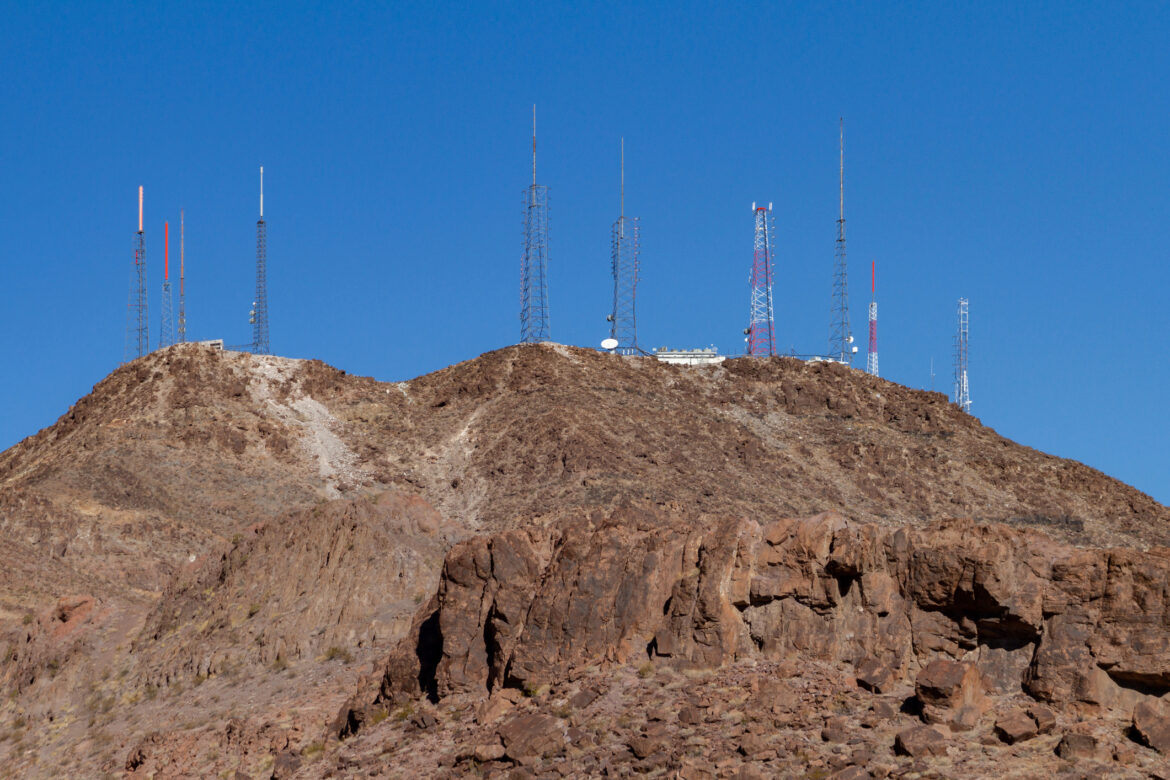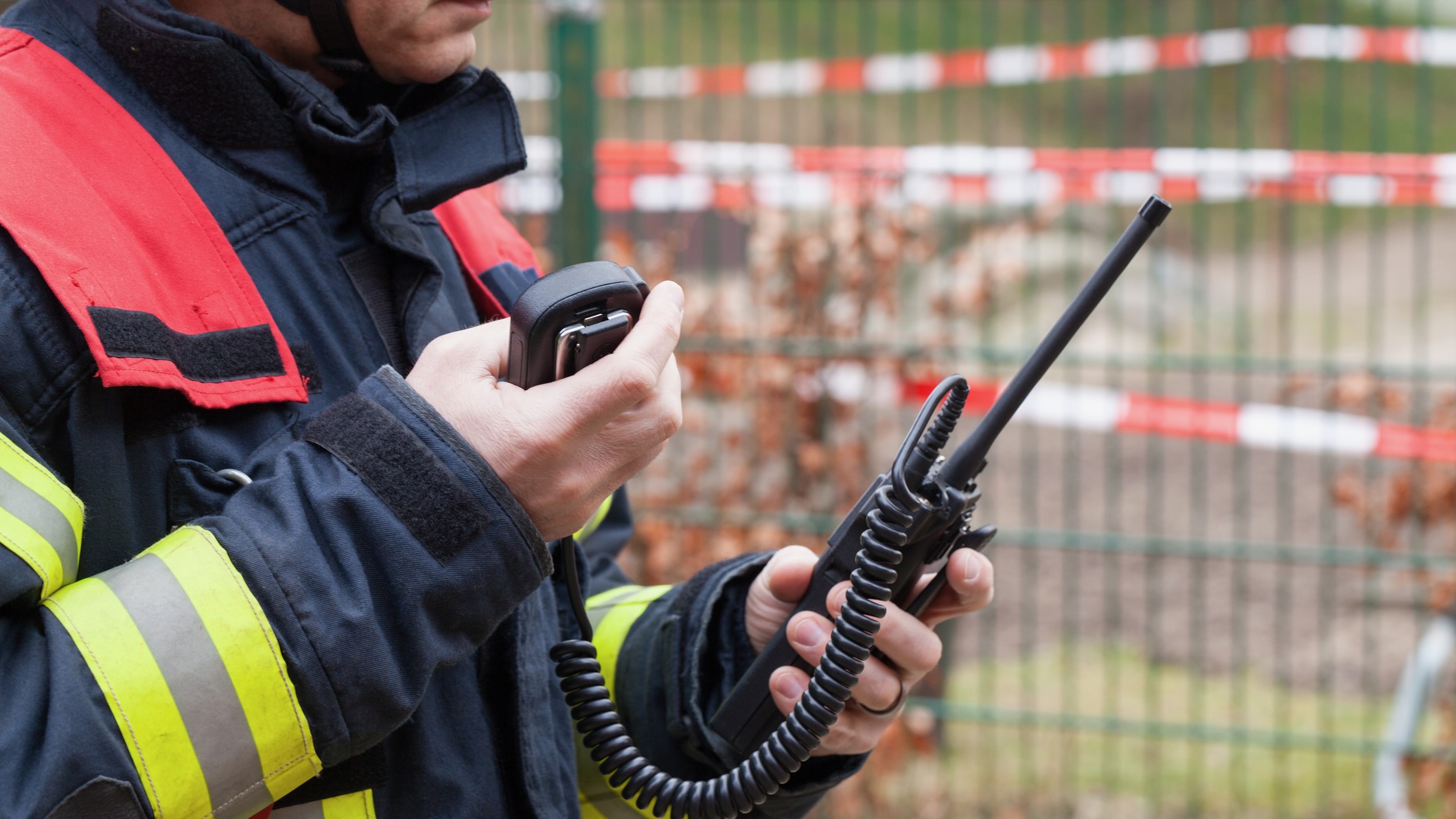New tech promises better signals, more interactivity and data options for pubcasters

sanfel / iStock
Telecommunication radio and TV antenna towers on a mountain top in Henderson, Nevada.
The long-term future of audio delivery for broadcasters may be streaming and podcasting, but for now, terrestrial FM radio is still the most direct way pubcasters reach the bulk of their audience. At the recent NAB Show, Public Radio Engineering Conference and surrounding events in Las Vegas, technology developers offered new ways that they said would enhance broadcasters’ FM signals and help them to reach bigger audiences, along with better interactivity and data capacity.
On-channel boosters, which rebroadcast an FM signal on the same frequency to reach areas isolated by mountains and valleys, have been available to engineers for several decades. They come with serious limitations, however. Unless the area being served by a booster is completely blocked from a station’s main signal, the main and booster signals tend to interfere with each other, making reception worse instead of better for many stations that have tried to use them. Only a handful of pubcasters have used them successfully, such as KUSC in Los Angeles, which uses a booster to reach a pocket of population in the Santa Clarita area, 40 miles northeast of downtown Los Angeles and completely blocked by high mountains from the station’s main transmitter on Mount Harvard above Pasadena.
In flat terrain – think Boston or Chicago – boosters have been unusable because of those limitations, but that is changing. Consulting engineer Bert Goldman explained to PREC attendees that it is now possible to better manage the precise synchronization between a main signal and a booster to reduce self-interference, as well as to better predict signal coverage in order to target boosters toward desired audiences.
Instead of just using a single booster with relatively high power, Goldman says he and his colleagues at Geo Broadcast Solutions have developed a system to build out multiple lower-powered boosters into what amounts to a “single frequency network” or SFN that functions almost like a cellular wireless network to predict small patches of weak coverage from a main transmitter and fill them with boosters.
“We figure about 80% of the stations in the country have some areas of coverage problems,” Goldman said. “These single frequency networks can significantly help in those places. Obviously, impaired signals mean lower revenue, and we’ve seen some pretty remarkable results after we’ve implemented these systems.”
More boosters — and more zones?
As FM signals have added additional technology such as ratings watermarks, metadata and HD Radio, the challenge of precisely designing and synchronizing multiple boosters has grown. Goldman says GBS’ SFN networks have demonstrated the ability to deliver Nielsen ratings watermarking, improving the ability for stations in markets that use Nielsen’s Portable People Meter technology to better register listening. For stations using HD Radio, he says the booster system can also deliver digital signals that can better overcome multipath interference for cleaner reception in hilly terrain or among downtown skyscrapers.

All that technology doesn’t come cheaply. Many GBS SFN systems, like the example Goldman presented of a new installation in San Francisco’s East Bay region for commercial broadcaster Audacy, involve multiple sites and significant engineering expenses. Audacy has three stations using the technology there and sharing five booster sites. Equipment for each station at each site costs about $50,000, Goldman said, plus GBS’ engineering costs, FCC filing expenses and ongoing rent.
In hopes of making that technology pay for itself, GBS is part of an FCC rulemaking proceeding seeking permission for stations to split their programming for several minutes every hour. “Zonecasting,” as GBS has dubbed the technique, would allow stations to provide traffic reports, advertising or event listings targeted to specific geographic areas within a larger market.
That’s been a controversial topic among engineers, who have had questions about whether the technology would result in a back-and-forth cacophony as listeners drive in and out of booster signals. Goldman’s PREC presentation included a video of a test of the system that split traffic reports in the Bay Area, showing audio switching smoothly between a main transmitter in San Jose and a booster as a vehicle drove into Contra Costa County, transferring the listener from a San Francisco traffic report to one focused on the booster zone.
For now, that technology has been of interest mainly to large commercial broadcasters, though GBS has also installed SFN systems for several noncommercial religious broadcasters, including EMF Broadcasting’s nationwide K-Love network.
Public radio engineering consultant Michael LeClair, formerly of WBUR in Boston, says it’s not clear how most public stations could benefit from zonecasting. While stations could theoretically split underwriting announcements into zoned areas, it would also create additional work in managing traffic for those split breaks, as well as providing separate audio feeds for each booster.
LeClair said those challenges come as part of larger changes in how public broadcasters reconceive their audio flow. One theme running through PREC and the NAB Show was “virtualization,” replacing automation hardware and legacy studio-transmitter links with cloud-based software that could deliver audio, metadata, national emergency alert system alerts, audio processing, HD Radio encoding and Nielsen ratings encoding directly to transmitter sites over internet paths.
Many vendors, including transmitter manufacturers such as Nautel and processing suppliers such as Orban, were promoting cloud-based virtualization in part as another level of emergency backup, allowing stations to continue to broadcast seamlessly from remote sites even if they lose access to studio facilities, a growing concern as the COVID-19 pandemic continues.
HD Radio innovations
Looking further out, Xperi, the owner of the HD Radio system, presented what it hopes will be the next version of digital radio in the US.
Ashruf El-Dinary, Xperi’s SVP for digital platforms, unveiled a proposed system that would add additional digital carriers with a new modulation scheme that will function alongside the existing nearly two-decades-old HD Radio system.
The new modulation system, called 16QAM, would allow next-generation HD Radio receivers to get more data from stations broadcasting it, opening up possibilities for improved audio quality, additional subchannels and enhanced metadata, including video clips and interactive links.
The system, still in its infancy, would require new radios to receive the enhanced data and audio, as well as new encoders to transmit it. The installed base of existing receivers, still estimated to be only about 30% of cars currently on the road, would be able to continue receiving the current layer of HD Radio but would not pick up the enhanced system.
El-Dinary said Xperi continues to work with auto manufacturers to increase HD Radio penetration in the dashboard. He projected that new receivers for the enhanced system could begin appearing in 2025 model year vehicles.
“It could be really valuable to the HD system because we could use more data,” said consultant LeClair. He raised concerns about whether the enhanced system’s data carriers will be as robust as the existing system. If not, that could reduce useful signal coverage for listeners hoping to take advantage of the new system’s features.
On a more immediate level, the NAB Show floor featured some new hardware at all levels of the signal chain. Most notably, the size of transmitters continues to shrink even as power efficiency and reliability increase. Nautel unveiled its new analog-only NX line of rack-mounted transmitters ranging from 300 to 5,000 watts, available for shipment starting this fall. At the lower power levels, the new transmitters are designed for FM translators, low-power FM and other small signals. At that 5,000-watt level, the rack-mounted unit replaces what was once an entire cabinet of equipment, another sign of how much more compact broadcast hardware has become.






One of the most important things Xperi could do with any new implementation of HD Radio is to add a method by which receivers can use data bandwidth on the DAB carriers to seamlessly “download” software and firmware updates to the receivers. Thus making it possible to have the receivers evolve and adapt more fluidly with the times. A major limitation of HD Radio is that it’s trying to “compete” for users’ attention on the dash by providing a user experience that’s locked in time to when the original HD Radio DAB schema was designed and implemented in the late 1990’s. (!!!!!)
“The system, still in its infancy, would require new radios to receive the enhanced data and audio, as well as new encoders to transmit it.”
Really? Did the folks who run HD radio not get the memo that this did not work the first time HD radio was introduced? HD radio does not have a viable way forward especially as car infotainment systems move to Internet broadcasting.